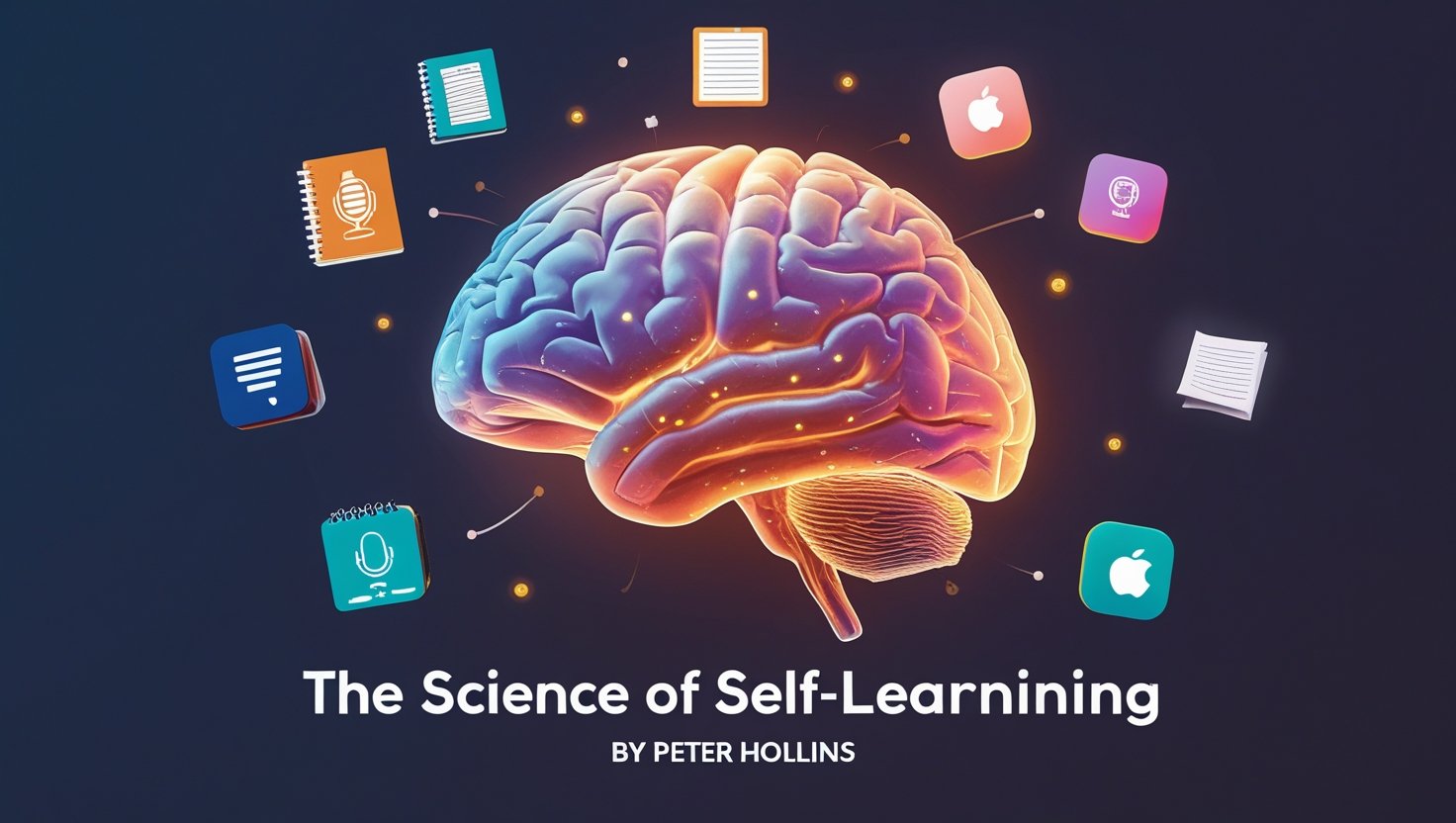
Self-learning is one of the most powerful skills a person can develop in today’s information-driven world. We live in an era where almost everything can be learned online, from mathematics to music, coding to cooking yet so many people still struggle to master new skills. Why is that? According to Peter Hollins in The Science of Self-Learning, the key is not only what we learn, but how we learn. This deeper awareness of our learning process is called metacognition. It is the art of thinking about our thinking and consciously refining the way we absorb, process, and retain knowledge.
Understanding the Concept of Metacognition:
Metacognition is essentially self-awareness applied to the act of learning. It involves two core components: awareness of how we think and control over how we manage that thinking. Many people try to learn new skills playing the guitar, solving complex math problems, or understanding a scientific concept without pausing to ask whether their approach is effective. As a result, they spend hours working hard but not necessarily working smart.
When we start monitoring our learning process, something remarkable happens. We begin to identify strategies that work for us, discard those that don’t, and adapt our approach as needed. Imagine reading a chapter without once stopping to check whether you truly understood it. Chances are, by the end, you’ll remember very little. But if you pause every few minutes, summarizing in your own words what you’ve just learned and asking yourself questions about it, your understanding becomes far deeper. Metacognition turns learning into an active, purposeful process rather than a passive, mechanical one.
Why Traditional Education Misses This Point:
One of the main reasons so many people struggle with learning is that schools often focus on completing the syllabus rather than teaching how to learn. Students are rarely encouraged to ask themselves, “Am I truly understanding this?” or “What can I do differently if this method isn’t working?” As a result, they grow up memorizing facts without developing the ability to analyze and refine their own learning style. This gap becomes more pronounced in adulthood, where self-directed learning becomes essential.
A metacognitive learner, however, doesn’t depend solely on a teacher or a guide. They become their instructor, constantly evaluating their progress, identifying areas for improvement, and making adjustments. They also use mistakes as learning opportunities, asking, “Why did I get this wrong?” instead of blaming themselves and moving on.
The Garden Analogy for Learning:
Think of your brain as a garden. If you simply water every plant the same way without understanding its needs, some plants will dry up, and others will be overwatered. But if you observe each plant closely, its sunlight requirements, soil type, and watering frequency, the garden thrives. Learning works in the same way. Each person’s mind is unique, and metacognition is the process of understanding how your “garden” works best so you can help it flourish.
A metacognitive learner does not blindly copy others’ study techniques. Instead, they evaluate which methods suit them, design an effective system, and fine-tune it over time. This self-awareness leads to faster, deeper, and more sustainable learning.
Active Reading – Moving Beyond Words:
One of the most practical ways to apply metacognition is through active reading. Many people fall into the trap of passive reading, moving their eyes over the words without questioning, analyzing, or summarizing. Passive reading may give a temporary sense of progress, but it leaves little behind in memory. Active reading, on the other hand, keeps your brain engaged throughout the process.
The first element of active reading is skimming and scanning the text to get an overview. This includes noticing main headings, subheadings, bold terms, and summaries. Skimming gives your brain a “map” of the content before diving into the details.
The second element is previewing and planning your reading session by identifying which sections are most important and what you want to gain from them. It’s like watching a movie trailer before the full film; you know what to look for when the main content begins.
The third and most crucial element is summarizing, restating what you’ve read in your own words. This step forces your brain to process the information, not just pass it through. When you summarize, you take ownership of the knowledge, making it easier to remember and apply.
Active reading transforms study sessions into interactive experiences. You underline key points, make margin notes, and ask yourself questions while reading. This approach not only deepens understanding but also improves recall.
The Feynman Technique – Teaching to Understand:
Another powerful method discussed by Hollins is the Feynman Technique, named after Nobel Prize-winning physicist Richard Feynman. Feynman believed that if you can’t explain a concept in simple terms, you don’t truly understand it. The technique involves breaking down a topic as if you were teaching it to a 12-year-old child using plain language, relatable examples, and no technical jargon.
When you attempt to explain a subject in this way, you quickly discover where your understanding is weak. These “gaps” become your next study targets. By repeatedly simplifying and re-explaining the material, you develop a crystal-clear grasp of the subject.
The Feynman Technique is not limited to academic subjects; it can be applied to any kind of learning, business concepts, software skills, or even philosophical ideas. It improves both comprehension and communication, making it a valuable tool for students and professionals alike.
Spaced Repetition – Training the Memory:
Understanding a concept is one thing, but retaining it over time is another. This is where spaced repetition comes in, a scientifically proven method of reviewing information at increasing intervals. Instead of cramming the same material every day, you review it after one day, then two days, then four, then a week, and so on. This timing leverages the brain’s natural forgetting curve, reinforcing the memory each time just before it’s likely to fade.
Spaced repetition saves time and energy by focusing on what you are about to forget, rather than reviewing everything repeatedly. It’s especially effective when combined with active recall, testing yourself on the material rather than simply re-reading it.
The Role of Mental Models in Learning:
Hollins also emphasizes the importance of mental model frameworks that shape how we think, interpret situations, and make decisions. Just as a builder uses different tools for different tasks, an effective thinker uses multiple mental models to approach problems from various angles. Some models come from economics, like opportunity cost; others from science, like first principles thinking; and still others from psychology, like second-order thinking.
By building a diverse “toolbox” of mental models, you can analyze situations more effectively, avoid common cognitive biases, and make smarter decisions. Mental models are formed through observation, experience, and continuous learning, making them a natural extension of the self-learning process.
Applying These Principles in the Digital Age:
In today’s world of constant distractions, social media, notifications, and endless multitasking, metacognition, active reading, and other self-learning strategies are more valuable than ever. They help you focus on what matters, retain information longer, and apply it in meaningful ways.
Reflection is another habit that can amplify your progress. Spending just 10–15 minutes at the end of each day reviewing what you learned, what you missed, and how you can improve tomorrow creates a compounding effect. Over weeks and months, these small improvements add up to massive growth.
Conclusion:
The core message of The Science of Self-Learning is that information alone is not power. The real power lies in knowing how to learn, remember, and apply what you’ve learned. By practicing metacognition, active reading, the Feynman Technique, spaced repetition, and mental modeling, you can transform yourself into a highly efficient, self-directed learner.
Self-learning is not a talent reserved for a few it is a skill that anyone can develop. It requires awareness, strategy, and consistency, but the rewards are enormous. Whether you are preparing for an exam, learning a new language, or mastering a professional skill, these principles can take your learning to the next level.
In the end, learning is both an art and a science. The art lies in tailoring the process to your unique mind; the science lies in using proven strategies to make it more effective. Peter Hollins shows us that with the right approach, anyone can master the art of learning and in doing so, master themselves.
FAQs:
1: What is metacognition, and why is it important in self-learning?
Metacognition is the ability to think about your own thinking. In learning, it means becoming aware of how you absorb, process, and retain knowledge. It allows you to monitor your progress, identify what works, and adjust strategies when needed. Without metacognition, people often waste time using ineffective methods and mistake effort for real progress. With it, learning becomes active, efficient, and sustainable.
2: Why does traditional education fail to teach self-learning skills?
Traditional education often focuses on completing the syllabus and memorizing facts instead of teaching how to learn. Students are rarely guided to reflect on whether they truly understand something or to adapt their methods when one approach doesn’t work. As a result, they graduate with information but without the skill of independent learning. In contrast, a self-learner becomes their own teacher, using mistakes as feedback and building lifelong adaptability.
3: How does the Feynman Technique improve understanding?
The Feynman Technique is about explaining a concept in the simplest terms possible, as if teaching it to a child. If you struggle to simplify or get stuck, it reveals gaps in your knowledge. By returning to the source, clarifying those gaps, and trying again, you develop a deeper and clearer understanding. This method ensures true mastery rather than surface-level familiarity.
4: What role does spaced repetition play in memory retention?
Spaced repetition is a scientifically backed technique for reviewing material at increasing intervals like after one day, three days, a week, and so on. This takes advantage of the brain’s natural forgetting curve, reinforcing knowledge just before it fades. Unlike cramming, which leads to quick forgetting, spaced repetition builds long-term retention and saves time by focusing on weak spots rather than reviewing everything constantly.
FAQ 5: How can these self-learning strategies be applied in the digital age?
In today’s distraction-filled world, strategies like metacognition, active reading, and spaced repetition are more valuable than ever. They help learners focus on essentials, filter out noise, and apply knowledge meaningfully. Simple habits like summarizing in your own words, reflecting daily on what you learned, and building a toolbox of mental models make learning more efficient. With consistency, these approaches compound over time, helping anyone thrive in both academic and professional fields.
